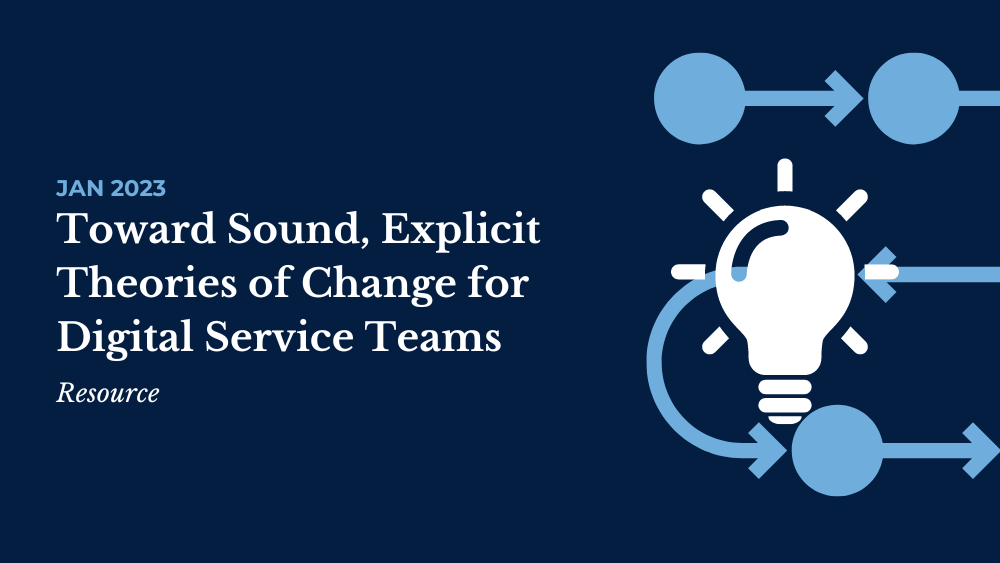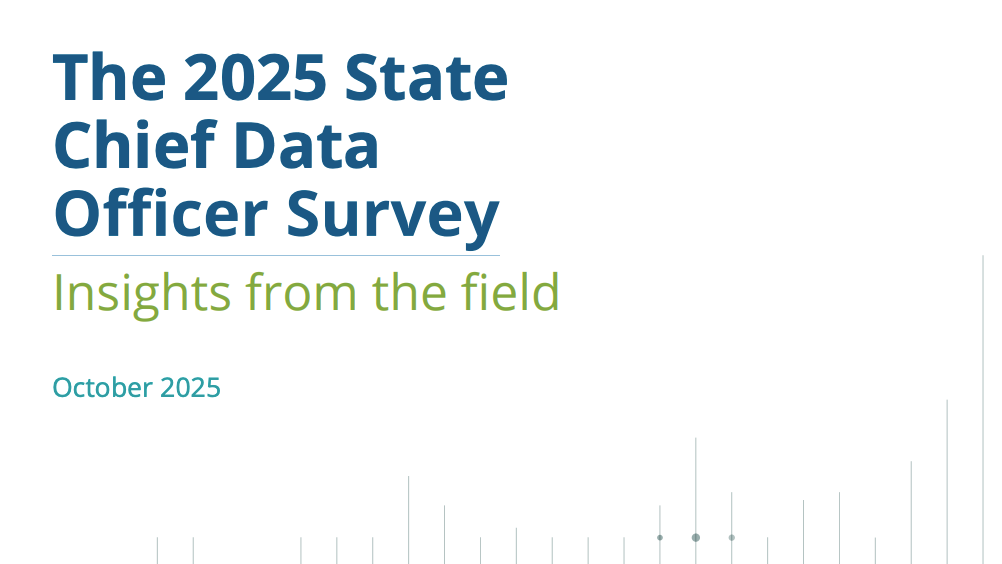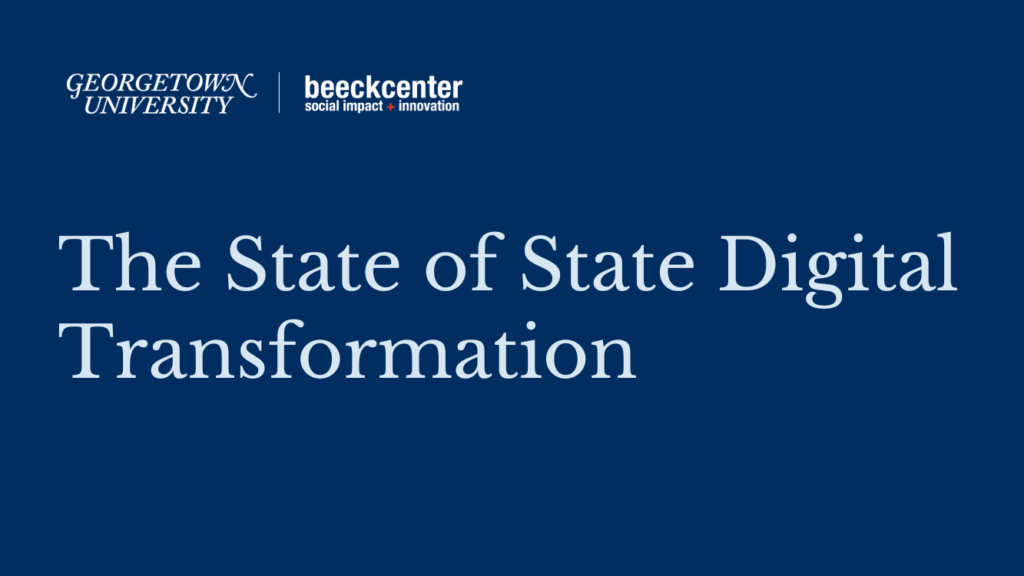Toward Sound, Explicit Theories of Change for Digital Service Teams
The Digital Service Network published two essays to kick-start new (or super-charge existing) theories of change for government digital service teams.

DSN ToC essay series
The Digital Service Network is publishing two essays to kick-start new (or super-charge existing) theories of change for government Digital Service teams.
- Toward Sound, Explicit Theories of Change for Digital Service Teams: ToC
overview and value proposition - Theories of Change for Digital Transformation in Government: Resource Appendix
Overview
Through our research on the digital transformation of government by Digital Service (DS) teams, the Digital Service Network (DSN) has heard many shared challenges across teams. Most common among these are:
- Difficulty recruiting allies across your organization
- General resistance to change
- Wavering team morale, particularly in long-term projects that stall or hit major roadblocks
- Challenges demonstrating value to decision makers
- Ambiguity in deciding what to work on given limited time and resources
These issues sit at the intersection of organizational management, communication, and relationship building, and there’s an inexpensive, lightweight tool that can help DS teams deal more productively with issues across all of these areas: a theory of change.
What is a theory of change?
A theory of change (ToC) is a clearly articulated strategy of how an individual or organization expects to bring about a desired change in a particular context.
A strong ToC needs a clear, logical description of how the actions taken will result in the desired outcomes. This should be supported by contextually-specific evidence. Accordingly, a ToC typically has three elements:
- A mapping of the current state
- An articulation of the desired end state
- A credible set of causal mechanisms to get from one to the other

Do you have a theory of change? (Spoiler alert: yes, you do!)
All DS teams operate under a ToC given the simple fact that their desired end state (i.e., digitally transformed government services that improve resident outcomes) is different from the typical current state (i.e., services that are outdated, inefficient, ineffective, etc.). The actions DS teams take are designed to move from the current state to a transformed state.The question for these teams is: is your ToC doing all the work for you that it can?
Why is a theory of change important for Digital Service teams?
There is a community of researchers and practitioners across a host of domains who agree that, broadly speaking, ToCs are useful and practical strategic tools that make achieving desired outcomes more likely; prevent mistakes by surfacing assumptions and dependencies; help teams align with stakeholders and better invest limited time and resources; and more.
While developing a sound, explicit ToC may sound like an academic, esoteric exercise, the DSN argues that a good ToC is, in fact, a pragmatic, lightweight tool which can be wielded for a host of tangible needs, like:
- Recruiting allies by helping teams communicate how their work is critical to realizing shared goals
- Strategically choosing a course of action
- Helping boost team morale by making clear why and how near-term work matters to long-term aims
“There is nothing as practical as good theory.”
– Harvard researcher Dr. Carol Weiss in her advice to those engaged in ambitious transformation efforts
Additionally, research tells us there is currently an evidence gap in our understanding of “whether [DS teams] as a machinery of government reform are crucial to achieving digital government success.”
This suggests that one of the best ways DS teams can operate in this uncertainty is by rigorously specifying how they think their team, in its given context, will affect the changes in government service delivery they seek—i.e., craft a sound, explicit ToC. Though a ToC isn’t the only thing required for meaningful evaluation, it’s difficult to evaluate efforts in the absence of a good one. A sound ToC equips DS teams and researchers to evaluate whether, to what extent, and why DS teams are able to achieve their objectives.
In short, another benefit to crafting a sound, explicit ToC is that it can help further the state of the field of digital government by providing important data to help DS teams (and the scholars who study them) evaluate their efforts and continuously improve their tactics.
A theory of change (for theories of change)
The DSN recommends DS teams spend time and energy creating a theory of change, because doing so will help them tackle a host of common problems in the space of government digital transformation. To illustrate the value of ToCs, the DSN would like to make our theory of change for this endeavor explicit.
DSN’s theory of change (for DS team theories of change!):
- The current state: DS teams face a set of common challenges, including difficulty recruiting allies, wavering team morale, struggling to demonstrate value to decision makers, ambiguity in deciding how to allocate resources, general resistance to change, and more.
- The desired end state: DS teams have clear ways to communicate their value internally and externally, find willing champions and allies, and leaders of DS teams have clear strategies to make use of limited time and resources, plus a rubric for evaluating those decisions.
- The causal mechanisms: Mapping their current state and clearly defining their desired end state is an opportunity for DS teams to build relationships within their team and with other government stakeholders and ensure their end goals are in alignment.
Specifying the mechanisms your team will use to achieve change (and making sure they are causal!) forces teams to make explicit precisely what they’re actually dependent on to achieve success—whether that’s the good will of certain individuals, legislative mandates, increased funding, specific technical outcomes, or a miracle from god.
A short-essay series on theories of change for Digital Service teams
We published two short essays for teams that want to kick-start a new (or super-charge an existing) ToC:
Part 1: Crafting a theory of change. We’ll break down each element of a sound, explicit ToC, including what each element is, why it’s essential, and advice for how to build it well.
Part 2: Wielding a theory of change. We’ll discuss three realms where DS teams might consider wielding their ToC—internally, with partners, and with executives—and the benefits a strong ToC can bring about in each of these spaces.
Each essay will feature advice and experiences from voices in the field, including:
- Matthew McAllister, former director of Colorado Digital Service (CDS)
- Stephanie Cain, former deputy director of Colorado Digital Service (CDS)
- Shira Honig, senior data policy advisor, Ontario Ministry of Children, Community and Social Services (MCCSS)
- Justin Elszasz, former chief data officer, Baltimore Mayor’s Office
DSN is thrilled to release this series and offer resources to support teams in approaching theories of change for more effective digital transformation in government.


